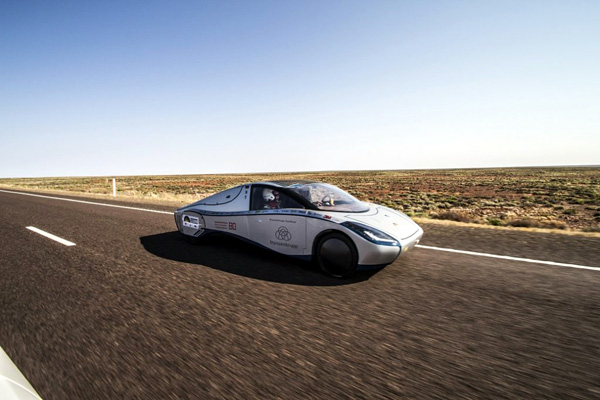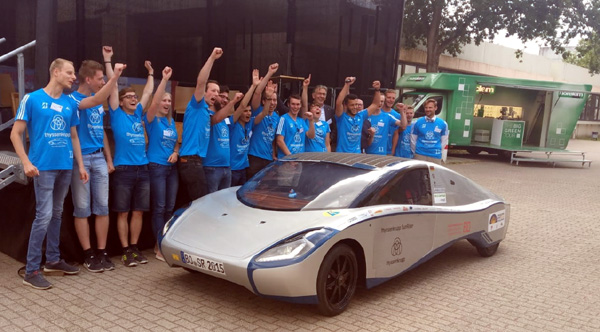February 27, 2020 |
Solarcar Team From Bochum University Of Applied Sciences Draws Conclusions From The Bridgestone World Solar Challenge 2019
At the Bridgestone World Solar Challenge (BWSC), in October 2019, the SolarCar team from Bochum University of Applied Sciences was able to defy many issues and successfully completed the challenge using Bridgestone Ecopia tyres with Ologic technology. Through strong teamwork, and supported by a lot of professional know-how, the team from Bochum University of Applied Sciences managed to successfully cover the distance with their thyssenkrupp SunRiser and achieved fourth place in the Cruiser Class. At the solar mobile show in Bochum, at the end of January 2020, the student team, together with project manager Sascha Rolle, talked about the experiences and difficulties in Australia - wind gusts, night shifts and the experiences that the team of students coped with.
In 2019, teams from many different countries competed against each other in the Down Under at the Bridgestone World Solar Challenge. A total of 15 groups, including the HS Bochum SolarCar team, competed in the Cruiser Class this year. Despite the particularly difficult conditions, Sascha Rolle was very proud of the performance and the result:

“We were able to achieve a good fourth place. Many of the teams did not even arrive in Adelaide to face these difficult conditions because they had battery problems, and there were even some accidents caused by the gusts of wind,” he said at the solar mobile show at the Bochum University of Applied Sciences at the end of January. "However, we were able to tackle any challenge thanks to extraordinarily good cooperation and excellent engineering."
Spontaneous engine change
Preparing for the 3,022 kilometre route from Darwin to Adelaide was not always easy. After the static technical acceptance by the organisers, the so-called "static scrutineering", the Bochum team had problems with the engines of the thyssenkrupp SunRiser during their many test drives, and during the days before the “dynamic scrutineering”. The young engineers had therefore had to work late into the night. “On the evening before the practical test drives and approvals, we had to make the serious decision, after a long period of consideration, to convert the thyssenkrupp SunRiser to our newly developed E-model motors in a night and fog campaign," said Sascha Rolle. "And it was worth it! The hardly tested engines worked flawlessly throughout the World Solar Challenge and, together with the dedication and spirit of the students, ensured that we were able to achieve fourth place. It is always impressive how the event, with its ups and downs, grows young people, who take something with them for their lives, ”continues Rolle.

A single endurance test
According to Sascha Rolle, the stage from Tennant Creek to Coober Pedy without a single charge stop, in particular, became an endurance test. This was especially true when the batteries became weaker and weaker and the day’s complications and unfavourable weather conditions, with heavy clouds and particularly strong winds, had a greater impact on the thyssenkrupp SunRiser than had been calculated. Many solar vehicles failed because of these circumstances.
“In order to remain in the classification, 30 kilometres before Coober Pedy, we had to load the thyssenkrupp SunRiser into our trailer and to trailer the last kilometres. As a result, we dropped out of the rating for those vehicles that did not have to use the trailer, ”said Rolle of the challenge.
"Nevertheless, our team wanted to cover the full mileage of the BWSC in its solar car, therefore we decided to bring the vehicle back to the place in front of Coober Pedy from which we had to use the trailer. This enabled us to cover the entire route in the thyssenkrupp SunRiser. "
With the support of the right tyres
Another decisive factor in the competition was the choice of the right tyres. "What is particularly important here is a low rolling resistance, which results from the rolling friction coefficient and the weight that is placed on the tyres," continued Rolle. For this reason, Bridgestone developed its Ecopia tyres with Ologic technology especially for the Bridgestone World Solar Challenge. These tyres are particularly fuel-efficient and optimised for rolling resistance.
“After the conversion, the thyssenkrupp SunRiser was heavier than in 2015 and therefore needed narrow-track tyres with a high load capacity, low consumption and high resistance to the high temperatures and the permanent load. Bridgestone has given us excellent support here with the Ecopia,” explained Sascha Rolle. Tyres with this technology are narrower than conventional standard tyres, have a larger diameter and, thanks to their special construction and tread compound, offer a particularly high level of fuel efficiency and safety. Due to the especially designed, smaller footprint of the Ecopia tyres, a lower rolling resistance can be achieved. This also improves fuel efficiency.
"In cooperation with the Bridgestone World Solar Challenge, we are particularly pleased to make an active contribution to the development of solar vehicles, to support young engineers and, above all, to preserve the environment through new mobility solutions," said Christian Mühlhäuser, Managing Director, Bridgestone Central Europe , “Using sunlight as an energy source can make a decisive contribution to more sustainable mobility. That is why Bridgestone will continue to support the BWSC as a title sponsor until 2030. ”
Source: Bridgestone

